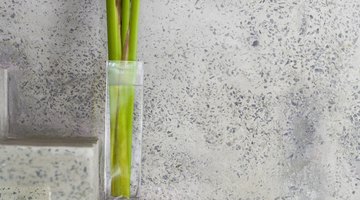How to Form Concrete Bullnose Steps
Forming bullnose edging on concrete steps creates a smooth rounded edge that helps to soften the appearance of the steps, while removing the sharp angles that chip easier than the more rounded bullnose edge. To create the bullnose, a form liner with the bullnose's molded shape is placed into the concrete form. Once the form is attached, the concrete poured into the form cures to the shape of the installed liner mold.

Things You Will Need
- 1/2-inch plywood sheets
- Circular saw
- 2-by-6-inch planks
- Nails
- Hammer
- Spade
- Tamp
- 2-by-4-inch stakes
- Asphalt mastic
- Trowel
- Bullnose liner
- 2-1/2-inch drywall screws
- Drill with screw set
- Form oil
- Paintbrush
- Concrete
- Wood float
- Darby
- Hand float
-
Create the sides of your concrete step forms using 1/2-inch plywood sheets. Cut the sheets to give you the step dimensions you need using the same angle for each step tread and riser. Add about 2 inches to the height of the bottom stair riser to allow for sinking the base of the staircase below ground 2 inches. Use a circular saw to cut one side out of the plywood and then place that sheet over a second sheet of plywood. Trace the cut edges onto the second sheet with a pencil, and then cut along the edges to create the second side of the form.
-
Cut 2-by-6-inch planks to the length of your staircase plus 1 inch, and then nail the planks to the front of the plywood sheets to create the front of the stair riser forms. Nail a 2-by-6-inch plank at each riser level on your plywood side forms.
-
Dig a 2-inch deep foundation hole into the ground at the stair location with a spade. Tamp the ground to compress the soil, and level it using a scrap plank and a carpenter’s level.
-
Place the stair form into the foundation against the wall where you’re attaching the stairs. Drive 2–by-4-inch stakes into the ground along the sides of the form, and then nail the stakes to the form to hold the form steady and level.
-
Place a layer of mastic 1/2-inch thick against the side of the structure the form is against with a trowel to seal the joint of the form and to provide an expansion joint between the stairs and the structure.
-
Cut a length of bullnose form liner to the same length of the stair risers with the saw. Place the liners on the inside edge of the risers, and then attach it in place with 2-1/2-inch drywall screws driven through the wood of the riser form and into the rear of the liner with a drill containing a screw set. Set the screws about 12-inches apart along the length of the riser. Make sure you do not set the screw through the liner front, as this will damage the bullnose.
-
Brush form oil over the inside surfaces of the form using a paintbrush to help you remove the forms after the concrete sets.
-
Fill the forms with concrete to the rim of each riser level. Tap along the front of the form with a hammer to remove any air bubbles against the form front. Run a wooden float across the tops of the steps using a sawing motion to level the concrete out, and then smooth the concrete surface with a darby. Allow any water on the surface of the concrete to evaporate and then smooth the surface with a trowel.
-
Allow the concrete to set for a few hours until firm, and then carefully pull away the form liners from the concrete surface to break the seal with the concrete. Remove the risers from the front of the form.
-
Run a hand float at the base of the risers over each step where it meets the riser to smooth out the surface of the joint between riser and step. Cut an expansion joint along the tread of the step from the riser to the step front every 18 inches, placing it 1/4-inch deep using a trowel.
-
Allow the concrete to cure for seven days while keeping the surface moist with sprinkled water. Wait another 21 days for the concrete to finish curing, and then remove the forms to reveal the steps with the bullnose edging.
References
Writer Bio
Larry Simmons is a freelance writer and expert in the fusion of computer technology and business. He has a B.S. in economics, an M.S. in information systems, an M.S. in communications technology, as well as significant work towards an M.B.A. in finance. He's published several hundred articles with Demand Studios.
Photo Credits
- Jupiterimages/Polka Dot/Getty Images
- Jupiterimages/Polka Dot/Getty Images
More Articles



